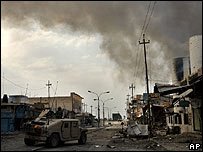
Are we becoming what we hate?
The Pentagon has confirmed that US troops used white phosphorus during last year's offensive in the northern Iraqi city of Falluja.
"It was used as an incendiary weapon against enemy combatants," spokesman Lt Col Barry Venable told the BBC - though not against civilians, he said.
The US earlier denied it had been used in Falluja at all.
Col Venable denied that the substance - which can cause burning of the flesh - constituted a banned chemical weapon.
White phosphorus is an incendiary weapon, not a chemical weapon
Col Barry Venable
Pentagon spokesman
Washington is not a signatory of an international treaty restricting the use of white phosphorus devices.
Col Venable said a statement by the US state department that white phosphorus had not been used was based on "poor information".
The BBC's defence correspondent Paul Wood says having to retract its denial has been a public relations disaster for the US military.
'Incendiary'
The US-led assault on Falluja - a stronghold of the Sunni insurgency west of Baghdad - displaced most of the city's 300,000 population and left many of its buildings destroyed.
Col Venable told the BBC's PM radio programme that the US army used white phosphorus incendiary munitions "primarily as obscurants, for smokescreens or target marking in some cases".
"However it is an incendiary weapon and may be used against enemy combatants."
WHITE PHOSPHORUS
Spontaneously flammable chemical used for battlefield illumination
Contact with particles causes burning of skin and flesh
Use of incendiary weapons prohibited for attacking civilians (Protocol III of Convention on Certain Conventional Weapons)
Protocol III not signed by US
And he said it had been used in Falluja, but it was "conventional munition", not a chemical weapon.
It is not "outlawed or illegal", Col Venable said.
"When you have enemy forces that are in covered positions that your high explosive artillery rounds are not having an impact on and you wish to get them out of those positions, one technique is to fire a white phosphorus round or rounds into the position because the combined effects of the fire and smoke - and in some case the terror brought about by the explosion on the ground - will drive them out of the holes so that you can kill them with high explosives," he said.
'Particularly nasty'
White phosphorus is highly flammable and ignites on contact with oxygen. If the substance hits someone's body, it will burn until deprived of oxygen.
Globalsecurity.org, a defence website, says: "Phosphorus burns on the skin are deep and painful... These weapons are particularly nasty because white phosphorus continues to burn until it disappears... it could burn right down to the bone."
A spokesman at the UK Ministry of Defence said the use of white phosphorus was permitted in battle in cases where there were no civilians near the target area.
But Professor Paul Rodgers of the University of Bradford department of peace studies said white phosphorus could be considered a chemical weapon if deliberately aimed at civilians.
He told PM: "It is not counted under the chemical weapons convention in its normal use but, although it is a matter of legal niceties, it probably does fall into the category of chemical weapons if it is used for this kind of purpose directly against people."
When the Rai documentary revealing the use of white phosphorus in Iraq was broadcast on 8 November, it sparked fury among Italian anti-war protesters, who demonstrated outside the US embassy in Rome.
Story from BBC NEWS:
http://news.bbc.co.uk/go/pr/fr/-/1/hi/world/middle_east/4440664.stm
Published: 2005/11/15 23:57:15 GMT
© BBC MMV
 Are we becoming what we hate?
Are we becoming what we hate?









